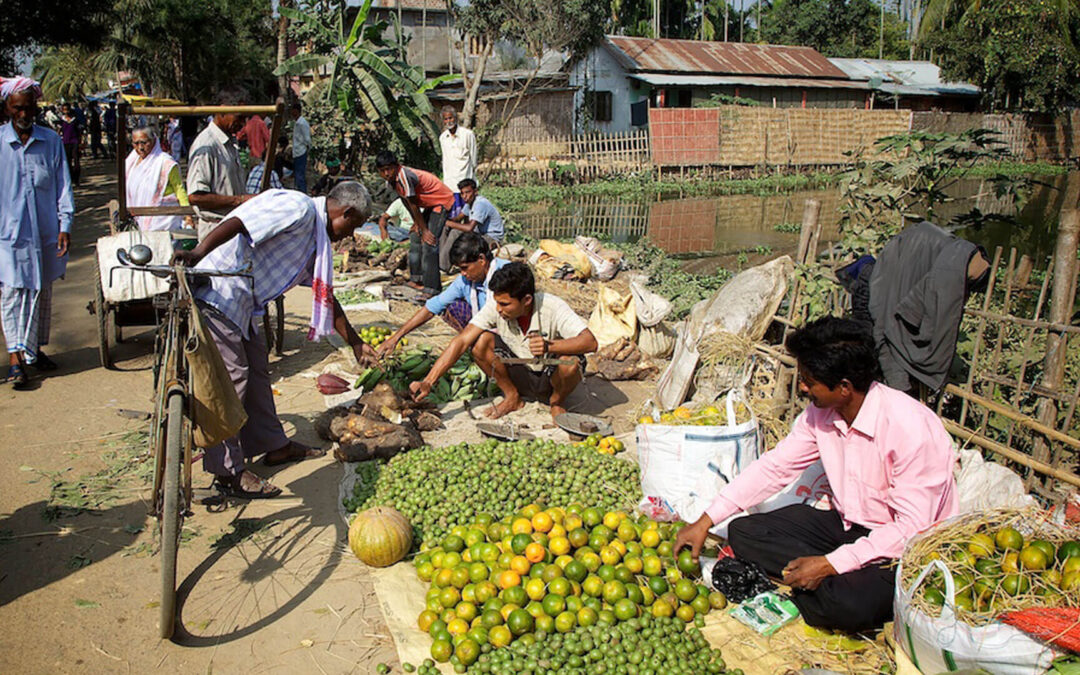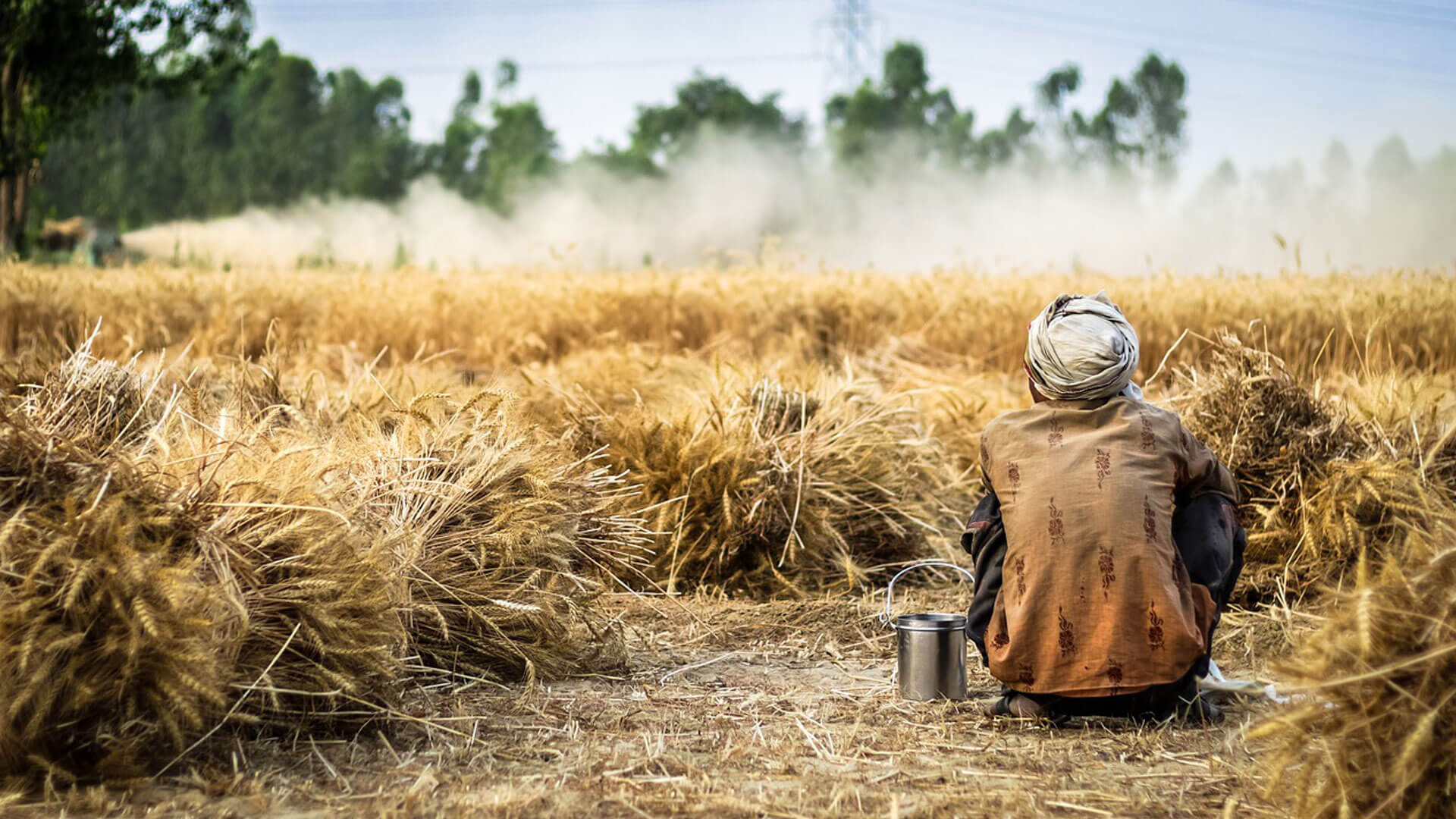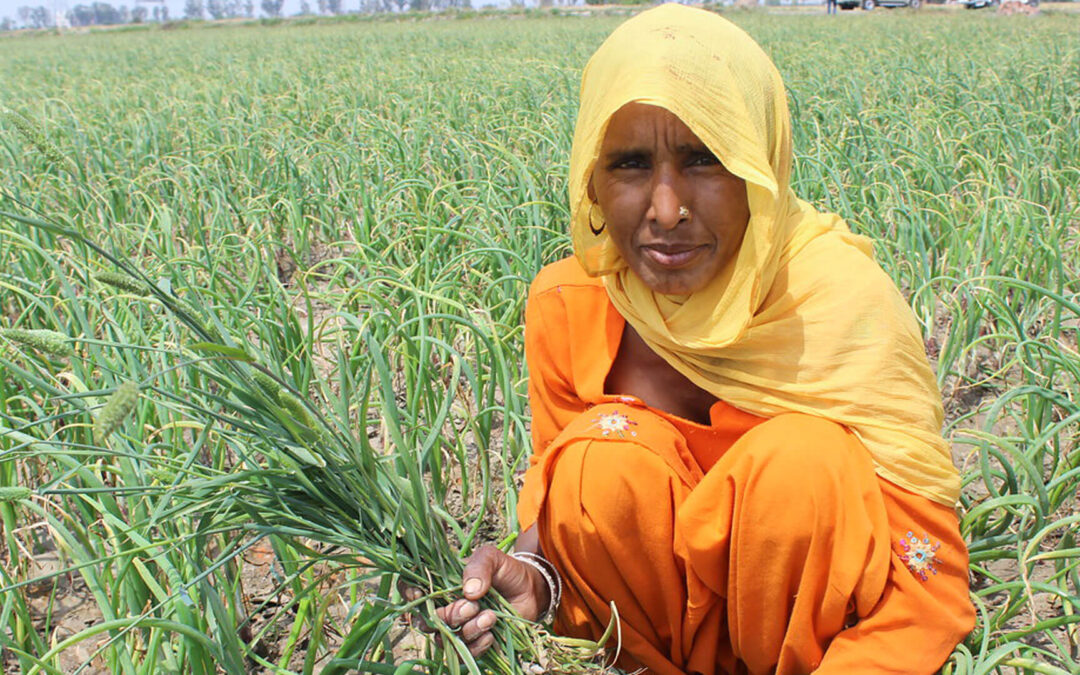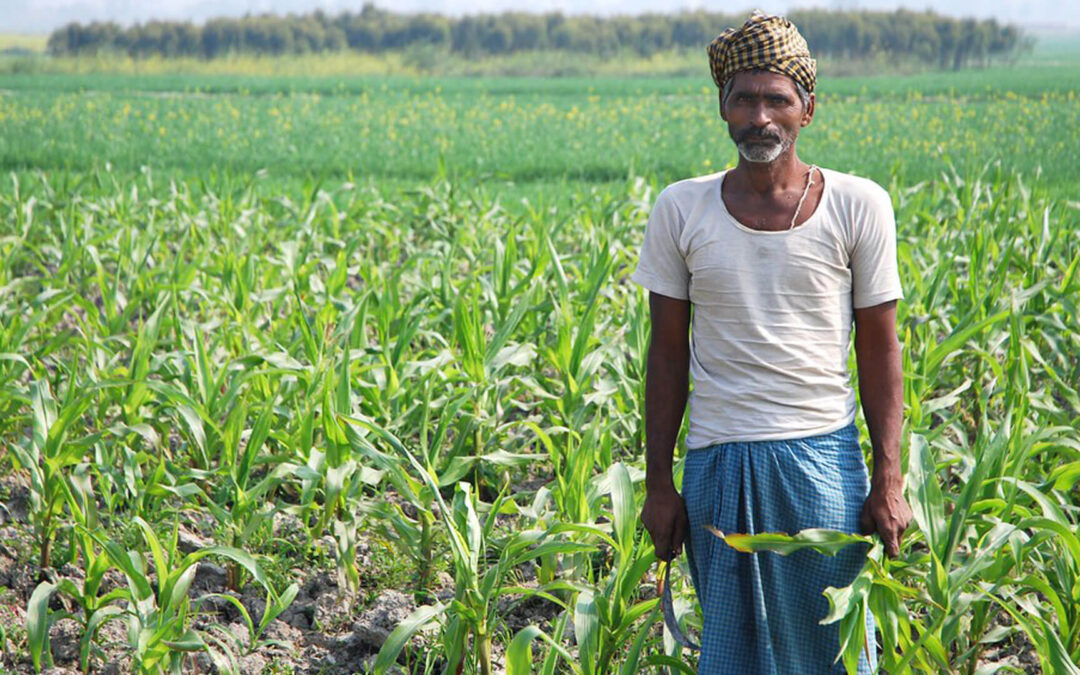The economy was in a depression even before March 2020. With the massive depression of demand that has taken place due to the Covid-19 lockdowns and the Government’s refusal to spend, many rural households that were earlier struggling to keep from falling would have been pushed over the edge.
(1) Reduced food consumption
Long before the Covid-19 lockdowns, it was well-known that food consumption in India was abysmally low. The United Nations’ Food and Agricultural Organisation (FAO) estimates that 70.5 per cent of Indians, or 973 million people, cannot afford a healthy diet, providing “not only adequate calories but also adequate levels of all essential nutrients and food groups needed for an active and healthy life”.
Physical measures of the nutritional status of Indians are among the worst in the world. The results from the 2019-21 round of the National Family Health Survey (NFHS) reveal that 35.5 per cent of Indian children under 5 years of age are stunted (low height for age); 13 states or Union Territories showed an increase in stunting over the previous survey. Wasting (low weight for height) affected 19.3 per cent of under-5s; again, 12 states or UTs showed increases in this indicator. Underweight (low weight for age) affected 32.1 per cent, with 16 states or UTs showing a worsening over the previous survey. Further, “NFHS-5 paints a grim picture of the anaemia problem in the country. It shows that 67.1 percent of children under the age of 5, 57 percent of women aged between 15 and 49, and 25 percent of all men aged 15 to 49 have anaemia. Not only does India have a severe anaemia problem, NFHS-5 reveals a worsening position when compared to NFHS-4.” As always, figures for undernutrition in the rural areas are worse than urban ones.
Another important pointer is the National Sample Survey (NSS) of households’ consumption expenditure. The latest such survey, covering the year 2017-18, found that household consumption expenditure had fallen in real terms in the six years since the earlier survey (2011-12). This appears to be the first such instance since the mid-1960s. While consumption expenditure stagnated in the urban areas, it fell sharply in the rural areas. As a part of this, food expenditure remained at the same level in the urban areas, but fell a massive 10 per cent in the rural areas. (In an unprecedented action, the Government suppressed this NSS report, claiming implausibly that they did so because there were problems with the quality of the data.)
Then came the lockdown of 2020. A number of unofficial surveys by various organisations documented the impact of the lockdown; 76 such surveys (as of April 2021) were compiled by the Centre for Sustainable Employment at Azim Premji University. Reviewing these surveys, Jean Drèze and Anmol Somanchi found that there was a sharp drop in food consumption by working people during the lockdown; moreover, follow-up surveys found that food consumption of these households, particularly of nutritious items, did not return to its earlier levels even after the lockdown.
For example, the Azim Premji University Covid-19 Livelihoods Phone Survey (CLIPS) interviewed people in two rounds, April-May 2020 and October-December 2020, i.e., during and after the nationwide lockdown. In the second round, 87 per cent of rural respondents said their food intake had decreased during the lockdown, but even after the lockdown was lifted, the intake of 59 per cent of rural respondents remained lower than before the lockdown.
Surveys of rural households by the Foundation for Agrarian Studies (FAS) in April and October 2020 similarly reported cutbacks in food intake during the lockdown, which persisted even after the lockdown was lifted. In October 2020, 45 per cent of respondents consumed less food than before the lockdown, due to reduced earnings, loss of employment, and rise in food prices. Worst affected were Scheduled Caste and manual workers. Nutritious foods, such as egg, meat, fish and green vegetables, were dropped from the diet.
While consumption also declined in the urban areas, the decline in food consumption in the rural areas is particularly striking, given the reasonably good harvest of foodgrains. Food was available, but working people lacked the income to buy it. The problem was not one of production, but of production relations.
(2) Indebtedness
When people’s incomes fail to meet their consumption needs, they are driven into debt. Drèze and Somanchi note:
In the absence of adequate relief measures, there was a surge in indebtedness in 2020, and also some distress sale of household assets. The proportion of sample households that were constrained to borrow or defer payments during the national lockdown varied between 38% and 53% in three major surveys. The corresponding proportions in follow-up surveys later in 2020 were lower, but still close to 20% (for the concerned reference period). Predictably, the compulsion to borrow was stronger for poorer households…. [A] significant minority of households were also constrained to sell or mortgage assets in 2020, during or after the national lockdown.
The FAS October 2020 survey of rural households similarly found that 35 per cent of respondents had taken loans, but only 6 per cent of these loans were from the formal sector. Poorer households took formal sector loans largely from micro-finance institutions or by pledging gold with commercial banks. Based on this survey, one study comments:
Poor peasant and manual worker households across the study villages reported that they had taken loans to meet increased costs of cultivation in the kharif season. The loans were taken from input dealers, moneylenders, local traders, and others at interest rates ranging from three to six per cent per month…. In contrast, landlords and rich capitalist farmers and rich peasants were in a better situation – most managed to get loans from commercial and cooperative banks, besides meeting additional expenses from their own savings. (emphasis added)
According to the CLIPS survey, 41 per cent of rural respondents took loans to cover consumption costs during the lockdown, and 23 per cent sold or pawned assets in order to do so.
Gold loans: One sign of the scale of distress in both urban and rural areas is the steep rise in the personal loans people took against gold from scheduled commercial banks (SCBs). The outstanding amount of such loans more than doubled between March-end 2020 and March-end 2021, rising from Rs 33,303 crore to Rs 74,458 crore, and remained at about the same level at end-March 2022.
In recent years, ‘non-banking financial corporations’ (NBFCs) specialising in gold loans, such as Muthoot Finance, Manappuram Finance, and IIFL Finance have grown rapidly. Outstanding NBFC gold loans tripled, from Rs 34,678 crore in March 2020 (roughly equal to the figure for banks) to Rs 94,840 crore in March 2021, and rose further to Rs 1,14,013 crore in September 2021.
Putting the banks and the NBFCs together, personal advances against gold rose from Rs 67,981 crore in March 2020 to Rs 169,298 crore in March 2021, a rise of 149 per cent.
However, personal gold loans are only a fraction of total gold loans extended by banks; the bulk of gold loans by banks are agricultural gold loans. Although the RBI does not release data for total gold loans by banks, data released by Bank of Baroda (BoB) may give us an idea of the proportions. BoB’s personal gold loans stood at Rs 1,117 crore in June 2021, but its agricultural gold loans were more than 20 times larger, at Rs 23,202 crore. Agricultural gold loans made up nearly a quarter of all BoB’s agricultural credit.
In 2019 itself, a Reserve Bank of India Internal Working Group had pointed to the fact that a sizeable share of ‘agricultural loans’ were being taken against gold, perhaps for consumption purposes. It is all the more likely that, in the Covid-19 period, many distressed rural households would have diverted part of their agricultural gold loans for consumption purposes. For example, BoB saw its agricultural gold loans jump by more than a third in the Covid-19 period, and by June 2021 such loans made up a considerably bigger share of its total agricultural lending than a year earlier.
Apart from this, data are not available on gold loans extended by private moneylenders, which could be larger than those by banks and NBFCs, and on more usurious terms. An RBI report noted:
In addition to a growing organised gold loans market, there is a large long-operated, unorganised gold loans market which is believed to be several times the size of organised gold loans market. There are no official estimates available on the size of this market, which is marked with the presence of numerous pawnbrokers, moneylenders and land lords operating at a local level. These players are quite active in rural areas of India and provide loans against jewellery to families in need at interest rates in excess of 30 percent. These operators have a strong understanding of the local customer base and offer an advantage of immediate liquidity to customers in need, with extreme flexible hours of accessibility, without requirements of any elaborate formalities and documentation. However, these players are completely un-regulated leaving the customers vulnerable to exploitation at the hands of these moneylenders and pawn-brokers.
(3) Implications of indebtedness
The growth of indebtedness has several implications. First, the perpetuation of low demand. These indebted persons would need to repay their loans, with interest, from their incomes. As a result, even after the lockdown their consumption may remain below the earlier level. Overall consumer demand would remain depressed, and the economy would find it hard to recover to its earlier level.
Recall that the earlier level was itself very low: in the last pre-Covid year, 2019-20, the economy had slumped dramatically, with the manufacturing sector shrinking 2.4 per cent and construction growing just 1 per cent. The principal reason for this slump was lack of demand. Now a return to even that low level of demand may be obstructed by the debts incurred during the lockdown.
It might be argued that the amount of demand emanating from these poor people would be small compared to the demand from the better-off, and hence its economic impact would be minimal. However, it is not only the quantum of demand, but the particular type of demand, which has an impact on the economy, particularly on employment. The goods the working people purchase are predominantly simple goods of mass consumption, often produced in the informal sector, and with little import content. Vast numbers of workers are employed in the sectors which make these goods, so a reduction in demand from the poor in turn leads to a sizeable loss of jobs. This vicious cycle of reduced demand of the working people and falling employment in the informal sector is precisely the pattern we have been witnessing in recent years.
(4) The burden of debt
In such a depressed economy, a certain number of indebted persons would be unable to repay their debts, and would lose their assets. Their first line of defence would likely be to sell movable assets such as livestock, equipment and jewellery (i.e., not land and buildings). Such movable assets, however, make up only 8.5 per cent of the total assets of rural households. The debts of indebted rural households (both cultivators and non-cultivators) in 2019 were 126 per cent as large as their movable assets. The poorer the indebted household, the higher is the ratio of its debt to its movable assets (see Chart 1 below). This condition would no doubt have worsened during the last 18 months.
Source: Calculated from All India Debt and Investment Survey 2019, Table A11R. 1 to 10 refer to deciles of households according to size of assets. Movable assets are assets other than land and buildings.
Poorer rural households are forced to take a greater share of their loans from what are called ‘non-institutional sources’ – such as moneylenders, input dealers, chit funds, landlords, relatives and friends, which we can abbreviate to ‘moneylender+’ debt. Part of the reason for this is that poorer households lack access to most ‘institutional’ sources, such as banks and cooperatives, which we can call ‘bank+’ debt. For at least the bottom 30 per cent of rural households, the share of such ‘moneylender+’ debt is higher than that of ‘bank+’ debt (Chart 2).
Source: All India Debt and Investment Survey 2019, Table A28R. 1 to 10 refer to deciles of households according to size of assets.
This means the poorer rural households pay a higher rate of interest overall: the average interest rate on rural ‘bank+’ loans is 11 per cent, but for ‘moneylender+’ debt, it is nearly double that, at 20 per cent.
A further twist is that the poorer the household, the higher is the interest rate charged by the lender, whether it be a bank or a moneylender. Thus the poorest rural households borrow from ‘bank+’ sources at an interest rate of 13 per cent, while the wealthiest borrow at 9 per cent; the poorest households borrow from ‘moneylender+’ sources at 23 per cent, the wealthiest borrow at 17 per cent.
Source: Calculated from All India Debt and Investment Survey 2019, Table A28R. 1 to 10 refer to deciles of households according to size of assets.
It should be noted that bank lending in the rural areas is done almost wholly by public sector banks and cooperative banks; private sector bank branches are hardly to be found in rural India. Now the Government has announced its plans to privatise most of the public sector banks, which will leave the field in the rural areas clear for various types of moneylenders, both traditional ones and new types.
Two such new types of moneylenders are hardly less usurious than traditional moneylenders: the average interest rate charged by micro-finance NBFCs is 24.4 per cent; that of gold loan NBFCs is at least 22 per cent and is probably higher. The RBI recently announced plans to remove all limits on the interest rates charged by micro-finance NBFCs.
(5) Loss of assets
As distress deepens, many households are already unable to repay their gold loans, as a result of which their gold is auctioned. NBFCs such as Manappuram Finance and IIFL Finance regularly advertise in newspapers for the auction of gold; for example, a single such advertisement, spread over two pages of the Business Standard, contains details of over 5,000 lots, and announces that auctions will be conducted at “the respective talukas/centres from where such loan was availed…. All defaulting borrowers have been duly intimated…”. Manappuram auctioned Rs 1,500 crore of gold in April-June 2021, more than three times the amount in the previous quarter.
The FAS survey cited earlier found that 16 per cent of the respondents had been forced to sell assets; this was particularly the case with members of Scheduled Castes, some of whom had been forced to sell their small land holdings.
Selling land is the last resort for most farm households, since work outside agriculture is insufficient on its own to meet the subsistence requirements of the family. In the latest official survey of farm households, the average such household had a monthly income of just Rs 10,218. Of this, about 40 per cent came from wages, 37 per cent from crop production, 15 per cent from farming of animals, and 6 per cent from non-farm business.
The sale of land, even if it enables the farm household to pay off its debts, would divest it of a sizeable share of its income, and perhaps a greater share of its overall sustenance (since an important – and likely undercounted – share of its consumption may come from village common property resources e.g. firewood, fodder, and wild edible plants). At the same time, employment in the non-agricultural sector is not growing rapidly to absorb those destituted in agriculture. If they are forced to part with their land, members of the family are forced to search for various employments, including in petty trade, in order to stitch together a living. It is a process of pauperisation.
The interrelation between larger demand-depressing policies and the alienation of the assets of the peasantry recalls the period of the Great Depression, when India was under colonial rule.



